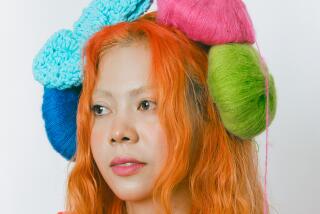New York Quilters Show Patterns of Urban Life
- Share via
NEW YORK — There is something comforting about quilts and quilting, something that evokes feelings of warmth, family and traditional values. Quilts seem to symbolize the ability to make order out of chaos, to stitch random bits of fabric into a grand design.
Traditionally, quilting has been a group endeavor, a patchwork of efforts. Friends and colleagues join together to sew, socialize and share technical knowledge and patterning skills.
Like society, quilt making is evolving. Traditional quilting circles still exist, often in rural areas, but a new breed of modern quilt maker is gaining recognition, even in cities like New York.
Contemporary New York quilt makers are fine artists whose medium is fabric. They generally acknowledge that their inspiration comes from New York City--itself a mix of cultures, rhythms and architecture.
“Quilters of the past drew inspiration from the familiar influences of daily life, such as religion, politics, nature and the home,” said quilt artist Karen Felicity Berkenfeld. “Similarly, today’s New York quilt makers are influenced by the highly charged atmosphere of the city, and use the contrasts of abstract and figurative imagery to create a narrative of urban life.”
Berkenfeld’s “Skyline Pigeon” ($1,700), a wall quilt 53 by 54 inches, is constructed of hand-printed, jungle-like or geometrical fabrics. The quilt celebrates New York through bright free-form pigeons soaring over an immovable skyline shown in subdued blues and grays.
New York quilters work individually, sometimes improvising on traditional quilting patterns but more often developing signature styles and personal themes, using hand-painted fabrics or unusual appliques to make aesthetic and social statements.
Like traditional quilters, they have a sense of community. To that end, Berkenfeld and a few other New York quilters created Manhattan Quilters Guild, an association that helps quilters share sources for fabric and technique and sometimes serves as an avenue through which the artists organize shows for museums such as the American Museum of Folk Art. The Guild also helps the artists refer commissions to each other. Founded in 1980, it now has 16 active members and seven affiliate members.
The organization maintains contacts with other quilting associations in the area and around the nation. It even has worldwide reach. Susan Faeder (2 Charlton Street 5A, New York 10014) leads tours to Japan, where participants meet with Japanese quilters and are taken to sources for fine and unusual Japanese fabrics.
Guild members Marilyn Henrion (505 LaGuardia Place 23D, New York 10012) and Diane Schneck are partners in ThreadEvents, an organization that runs quilting workshops and leads tours of New York fabric shops. Both have individual styles. Henrion creates dramatic, dynamic, asymmetrical abstractions ($3,150 and up if purchased from the artist or $4,500 and up if through a gallery), often using hand-printed fabrics, while Schneck’s work--which also is abstract--often uses antique fabric and is whimsical. Her Ugly Tie Quilt, for example, is made from men’s ties.
Paula Nadelstern (98 Van Courtlandt Park South, Apt. 9-C, New York 10463), lives and makes quilts on the same Bronx block where she was raised. Nadelstern is fascinated with kaleidoscopes and uses them repeatedly in her dazzling designs (from about $125 per square foot). The effect is magical. She also is author of several books on quilting.
Dee Danly-Brown (401 East 81st St. 10B, New York 10028) sometimes creates a kaleidoscopic effect but acknowledges the rich influence of urban themes and social and environmental concerns in her work. “Metropolitan Postcard” ($1,800), a 63- by-58-inch wall quilt, is a composite of black, white and gray solid and patterned cottons formed into an Escher-like landscape of the New York skyline.
Danly-Brown is former president of another New York quilting association, Empire Quilters (P.O. Box 6175, Grand Central Station, New York 10163-6019), a group with about 200 members.
Michael A. Cummings, a member of Empire Quilters, lives in Harlem, where he creates larger-than-life figurative quilts (from about $400 to $10,000) based on Afro-American themes. He is currently at work on an African Jazz Series.
Judy Speezak (Box 2528, Rockefeller Center Station, New York 10185) is at the opposite end of the quilting spectrum. She works in calming colors and abstract patterns to create delightful baby quilts. Ready-made or made-to-order and priced from $400, they are intended to be used, treasured and handed down through the generations. Larger versions for adult beds are also available.
To meet with New York quilters, learn about quilting exhibitions and workshops, purchase or commission original works, write to the Manhattan Quilters Guild. Guild members will refer correspondence to the appropriate New York quilter or association. Prices vary greatly, but a base figure is $100 to $125 per square foot.
The Guild brochure, listing members and describing their work, is available free from Manhattan Quilters Guild, c/o Karen Felicity Berkenfeld, 150 West 79th St., New York 10014.
More to Read
The biggest entertainment stories
Get our big stories about Hollywood, film, television, music, arts, culture and more right in your inbox as soon as they publish.
You may occasionally receive promotional content from the Los Angeles Times.










